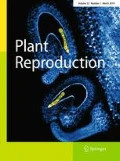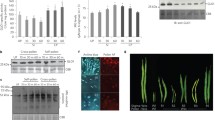Abstract
Members of the Brassicaceae family have the ability to regulate pollination events occurring on the stigma surface. In Brassica species, self-pollination leads to an allele-specific interaction between the pollen small cysteine-rich peptide ligand (SCR/SP11) and the stigmatic S-receptor kinase (SRK) that activates the E3 ubiquitin ligase ARC1 (Armadillo repeat-containing 1), resulting in proteasomal degradation of various compatibility factors including glyoxalase I (GLO1) which is necessary for successful pollination. In Brassica napus, the suppression of GLO1 was sufficient to reduce compatibility, and overexpression of GLO1 in self-incompatible Brassica napus stigmas resulted in partial breakdown of the self-incompatibility response. Here, we verified if BnGLO1 could function as a compatibility factor in the artificial self-incompatibility system of Arabidopsis thaliana expressing AlSCRb, AlSRKb and AlARC1 proteins from A. lyrata. Overexpression of BnGLO1 is sufficient to breakdown self-incompatibility response in A. thaliana stigmas. Therefore, GLO1 has an indisputable role as a compatibility factor in the stigma in regulating pollen attachment and pollen tube growth. Lastly, this study demonstrates the usefulness of an artificial self-incompatibility system in A. thaliana for interspecific self-incompatibility studies.






Similar content being viewed by others
References
Azibi T et al (2020) Impact of whole genome triplication on the evolutionary history and the functional dynamics of regulatory genes involved in Brassica self-incompatibility signalling pathway. Plant Reprod 33:43–58
Boavida LC et al (2011) Whole genome analysis of gene expression reveals coordinated activation of signaling and metabolic pathways during pollen–pistil interactions in Arabidopsis. Plant Physiol 155:2066–2080
Boggs NA et al (2009) Expression of distinct self-incompatibility specificities in Arabidopsis thaliana. Genetics 182:1313–1321
Borges F et al (2008) Comparitive transcriptomics of Arabidopsis sperm cells. Plant Physiol 148:1168–1181
Castric V, Billiard S, Vekemans X (2014) Trait transitions in explicit ecological and genomic contexts: plant mating systems as case studies. Adv Exp Med Biol 781:7–36
Charlesworth D, Vekemans X (2005) How and when did Arabidopsis thaliana become highly self-fertilising. BioEssays 27:472–476
Clough SJ, Bent AF (1998) Floral dip: a simplified method for Agrobacterium-mediated transformation of Arabidopsis thaliana. Plant J Cell Mol Biol 16(6):735–743. https://doi.org/10.1046/j.1365-313x.1998.00343.x
de Nettancourt D (2001) Incompatibility and incongruity in wild and cultivated plants, 2nd edn. Springer, Berlin
Franzke A, Lysak MA, Al-Shehbaz IA, Koch MA, Mummenhoff K (2011) Cabbage family affairs: the evolutionary history of Brassicaceae. Trends Plant Sci 16:108–116
Ghosh A, Islam T (2016) Genome-wide and expression profiling of glyoxalase gene families in soybean (Glycine max) indicate their developmental and abiotic stress specific response. BMC Plant Biol 16:87
Gu T, Mazzurco M, Sulaman W, Matias DD, Goring DR (1998) Binding of an arm repeat protein to the kinase domain of the S-locus receptor kinase. Proc Natl Acad Sci USA 95:382–387
Heslop-Harrison J (1979) An interpretation of the hydrodynamics of pollen. Am J Bot 66:737–743
Hiscock S, Allen A (2008) Diverse cell signalling pathways regulate pollen-stigma interactions: the search for consensus. New Phytol 179:286–317
Honys D, Twell D (2004) Transcriptome analysis of haploid male gametophyte development in Arabidopsis. Genome Biol 5:R85
Hruz T et al (2008) Genevestigator v3: a reference expression database for the meta-analysis of transcriptomes. Adv Bioinform 2008:420747–420747
Indriolo E, Goring DR (2016) Yeast two-hybrid interactions between Arabidopsis lyrata S receptor kinase and the ARC1 E3 ligase. Plant Signal Behav 11:e1188233
Indriolo E, Tharmapalan P, Wright SI, Goring DR (2012) The ARC1 E3 ligase gene is frequently deleted in self-compatible Brassicaceae species and has a conserved role in Arabidopsis lyrata self-pollen rejection. Plant Cell 24:4607–4620
Indriolo E, Safavian D, Goring DR (2014) The ARC1 E3 ligase promotes two different self- pollen avoidance traits in Arabidopsis thaliana. Plant Cell 26(4):1525–1543
Ivanov R, Fobis-Loisy I, Gaude T (2010) When no means no: guide to Brassicaceae self-incompatibility. Trends Plant Sci 15:387–394
Iwano M, Takayama S (2012) Self/non-self discrimination in angiosperm self-incompatibility. Curr Opin Plant Biol 15:78–83
Jain M, Batth R, Kumari S, Mustafiz A (2016) Arabidopsis thalina contains both Ni2+ and Zn2+ dependent glyoxalase I enzymes and ectopic expression of the latter contributes more towards abiotic stress tolerance in E. coli. PLoS ONE 11:e0159348. https://doi.org/10.1371/journal.pone.0159348
Kachroo A, Schopfer CR, Nasrallah ME, Nasrallah JB (2001) Allele-specific receptor-ligand interactions in Brassica self-incompatibility. Science 293:1824–1826
Kakita M et al (2007) Two distinct forms of the M-locus protein kinase localize to the plasma membrane and interact directly with the S-locus receptor kinase to transduce self-incompatibility signaling in Brassica rapa. Plant Cell 19:3961–3973
Kaur C, Singla-Pareek SL, Sopory SK (2014) Glyoxalase and methylglyoxal as biomarkers for plant stress tolerance. Crit Rev Plant Sci 33:429–456
Kusaba M, Dwyer K, Hendershot J, Vrebalov J, Nasrallah JB, Nasrallah ME (2001) Self-incompatibility in the genus Arabidopsis: characterization of the S locus in the outcrossing A. lyrata and its autogamous relative A. thaliana. Plant Cell 13:627–643
Murase K, Shiba H, Iwano M, Che FS, Watanabe M, Isogai A, Takayama S (2004) A membrane-anchored protein kinase involved in Brassica self-incompatibility signaling. Science 303:1516–1519
Mustafiz A, Singh A, Pareek A, Sopory SK, Singla-Pareek SL (2011) Geneome-wide analysis of rice and Arabidopsis identifies two glyoxalase genes that are highly expressed in abiotic stress. Funct Integr Genom 11:293–305
Nasrallah ME, Liu P, Nasrallah JB (2002) Generation of self-incompatible Arabidopsis thaliana by transfer of two S locus genes from A. lyrata. Science 297:247–249
Nasrallah ME, Liu P, Sherman-Broyles S, Boggs NA, Nasrallah JB (2004) Natural variation in expression of self-incompatibility in Arabidopsis thaliana: implications for the evolution of selfing. Proc Natl Acad Sci USA 101:16070–16074
Qin Y, Leydon AR, Manziello A, Pandey R, Mount D, Denic S, Vasic B, Johnson MA, Palanivelu R (2009) Penetration of the stigma and style elicits a novel transcriptome in pollen tubes, pointing to genes critical for growth in a pistil. PLoS Genet 5:e1000621
Safavian D, Goring DR (2013) Secretory activity is rapidly induced in stigmatic papillae by compatible pollen, but inhibited for self-incompatible pollen in the Brassicaceae. PLoS ONE 8:e84286
Safavian D, Zayed Y, Indriolo E, Chapman L, Ahmed A, Goring D (2015) RNA silencing of exocyst genes in the stigma impairs the acceptance of compatible pollen in Arabidopsis. Plant Physiol. https://doi.org/10.1104/pp.15.00635
Samuel MA, Mudgil Y, Salt JN, Delmas F, Ramachandran S, Chilelli A, Goring DR (2008) Interactions between the S-domain receptor kinases and AtPUB-ARM E3 ubiquitin ligases suggest a conserved signaling pathway in Arabidopsis. Plant Physiol 147:2084–2095
Samuel MA, Chong YT, Haasen KE, Aldea-Brydges MG, Stone SL, Goring DR (2009) Cellular pathways regulating responses to compatible and self-incompatible pollen in Brassica and Arabidopsis stigmas intersect at Exo70A1, a putative component of the exocyst complex. Plant Cell 21:2655–2671
Sankaranarayanan S, Jamshed M, Samuel MA (2015) Degradation of glyoxalase I in Brassica napus stigma leads to self-incompatibility response. Nat Plants 1:15185
Sankaranarayanan S et al (2017) Glyoxalase goes green: the expanding roles of glyoxalase in plants. Int J Mol Sci 18:898
Scandola S, Samuel MA (2019) A flower-specific phospholipase D is a stigmatic compatibility factor targeted by the self-incompatibility response in Brassica napus. Curr Biol 29:506–512.e504
Schierup MH, Bechsgaard JS, Nielsen LH, Christiansen FB (2006) Selection at work in self-incompatible Arabidopsis lyrata: mating patterns in a natural population. Genetics 172:477–484
Schmitz J, Rossoni AW, Maurino VG (2018) Dissecting the physiological function of plant glyoxalase i and glyoxalase I-like proteins. Front Plant Sci. https://doi.org/10.3389/fpls.2018.01618
Shimosato H et al (2007) Characterization of the SP11/SCR high-affinity binding site involved in self/nonself recognition in brassica self-incompatibility. Plant Cell 19:107–117
Singla-Pareek S, Kaur C, Kumar B, Pareek A, Soropry SK (2020) Reassessing plant glyoxalases: large family and expanding functions. New Phytol. https://doi.org/10.1111/nph.16576
Smyth DR, Bowman JL, Meyerowitz EM (1990) Early flower development in Arabidopsis. Plant Cell 2:755–767
Stone SL, Arnoldo M, Goring DR (1999) A breakdown of Brassica self-incompatibility in ARC1 antisense transgenic plants. Science 286:1729–1731
Stone S, Anderson E, Mullen R, Goring D (2003) ARC1 is an E3 ubiquitin ligase and promotes the ubiquitination of proteins during the rejection of self-incompatible Brassica pollen. Plant Cell 15:885–898
Strickler SR, Tantikanjana T, Nasrallah JB (2013) Regulation of the S-locus receptor kinase and self-incompatibility in Arabidopsis thaliana. G3 Genes Genomes Genet 3:315–322
Tantikanjana T, Nasrallah ME, Nasrallah JB (2010) Complex networks of self-incompatibility signaling in the Brassicaceae. Curr Opin Plant Biol 13:520–526
Thornalley PJ (1990) The glyoxalase system: new developments towards functional characterization of a metabolic pathway fundamental to biological life. Biochem J 269:1–11
Tsuchimatsu T et al (2010) Evolution of self-compatibility in Arabidopsis by a mutation in the male specificity gene. Nature 464:1342–1346
Wang X et al (2011) The genome of the mesopolyploid crop species Brassica rapa. Nat Genet 43:1035–1039
Zhang T et al (2019) Generation of transgenic self-incompatible arabidopsis thaliana shows a genus-specific preference for self-incompatibility genes. Plants (Basel) 8:570
Funding
Support for the Indriolo laboratory was provided by university start-up funds provided to Emily Indriolo from NMSU. Support for undergraduate researcher Patrick Kenney was provided by the Howard Hughes Medical Institute, Research Scholars Program: #52008103.
Author information
Authors and Affiliations
Contributions
SS and EI initiated the project and designed research; PK, SS, MB and EI performed all of the experiments. MB and EI statistically analyzed the results. EI and SS wrote the manuscript. EI obtained funding and supervised the project. All authors discussed the results and commented on the manuscript. The authors would lastly like to thank Ms. Alejandra Cobos and Dr. Marcus Samuel for critical feedback on the manuscript.
Corresponding author
Additional information
Communicated by Dolf Weijers.
Publisher's Note
Springer Nature remains neutral with regard to jurisdictional claims in published maps and institutional affiliations.
Electronic supplementary material
Below is the link to the electronic supplementary material.
497_2020_392_MOESM1_ESM.tif
Supplemental Fig. 1. Additional Aniline Blue stains of A. thaliana stigmas 2 h post pollination. Manual self-pollination results of Sha wild-type compatible pollinations, Sha incompatible pollinations of AlARC1 + AlSRKb + AlSCRb lines and the Sha BnGLO1 + AlARC1 + AlSRKb + AlSCRb lines. Scale bar = 50 μm. (TIFF 8029 kb)
497_2020_392_MOESM2_ESM.eps
Supplemental Fig. 2. The reproductive expression data series of Arabidopsis thaliana Glyoxalase family members generated with (https://www.genevestigator.com). (EPS 2483 kb)
497_2020_392_MOESM3_ESM.eps
Supplemental Fig. 3. PCR genotyping of all transgenic A. thaliana lines. A. thaliana Sha plants were genotyped for the presence of transgenes. Line 61, 76 and 81 were the plants that were positive for the presence of AlARC1, AlSCRb-AlSRKb and BnGLO1 with primers that were specific for each of these constructs. Sizes for each PCR product are included in the figure. The previously characterized A. thaliana Sha artificial self-incompatible lines 1, 2 and 5 were confirmed by PCR with the AlARC1 and the AlSCR-SRK constructs. (EPS 3272 kb)
497_2020_392_MOESM4_ESM.eps
Supplemental Fig. 4. qPCR of transgenic A. thaliana lines. Relative level of expression of AlSRKb, AlARC1 and AtTUB4 in BnGLO1 + AlARC1 + AlSRKb + AlSCRb lines 61, 76 and 81. Each sample had three technical replicates, and the entire plate was run two times. The expression of each gene was set to a baseline of zero using a Sha wild-type cDNA, and the expression from each transgenic line was subtracted from the wild-type expression to determine if there was an equal or increased level of expression in the transgenic A. thaliana lines. (EPS 1991 kb)
497_2020_392_MOESM5_ESM.eps
Supplemental Fig. 5. Self-incompatible aniline blue stain phenotypes. Brightfield and Aniline Blue stains of stigmas. Sha self-pollinations of BnGLO1 + AlARC1 + AlSRKb + AlSCRb lines 51, 68, and 83 show the rejection of self-pollen grains 2 h post pollination. Scale bar = 50μm. (EPS 4550 kb)
Rights and permissions
About this article
Cite this article
Kenney, P., Sankaranarayanan, S., Balogh, M. et al. Expression of Brassica napus GLO1 is sufficient to breakdown artificial self-incompatibility in Arabidopsis thaliana. Plant Reprod 33, 159–171 (2020). https://doi.org/10.1007/s00497-020-00392-y
Received:
Accepted:
Published:
Issue Date:
DOI: https://doi.org/10.1007/s00497-020-00392-y




